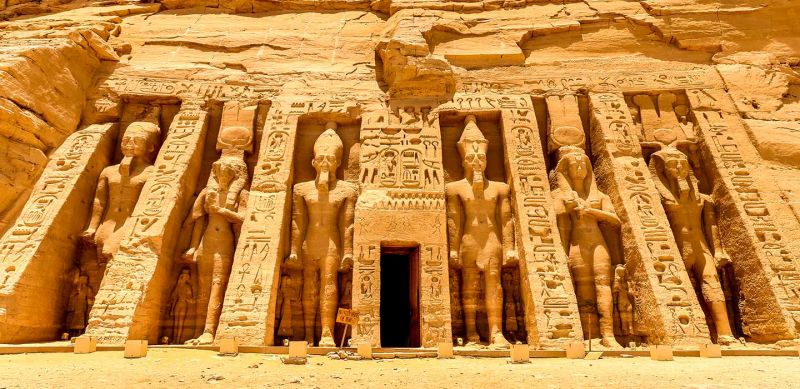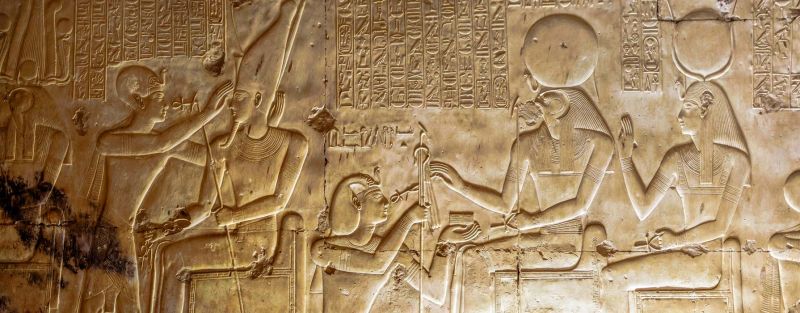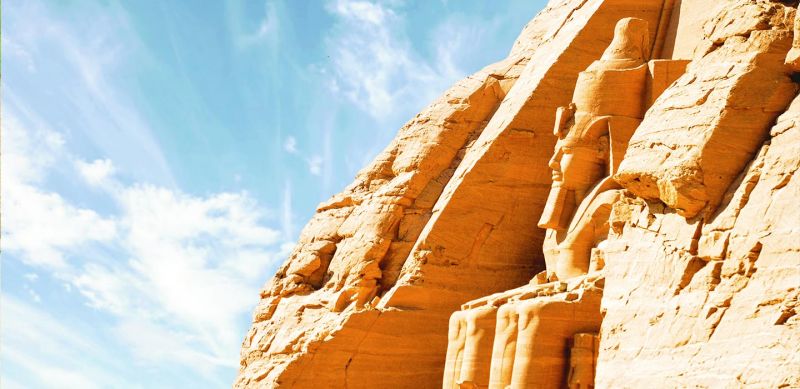Ramses II (1303a.c.-1213a.c.) was the last great Pharaoh of Egypt, he lived to be 90 years old, had 152 offspring, was red-haired and measured 190cm when he was alive
What are some facts about Ramses II?
Ramses II is one of the most famous Egyptian kings who ruled Egypt in its golden age. He is the mightiest third pharaoh of the 19th dynasty of Egypt. King Seti I gave the crown to Prince Ramses who turned to Ramses II. He gave him a house and harem, “prince of Egypt” Ramses participated in military campaigns with his father where he gained a solid military and kingship experience before he was a king.

In the following you will find answers to the most common questions about the history of Ramses II:
– Who is Ramses II?
– How long did Ramses II rule?
– Who are Ramses ii children? | Ramses ii family
– What were Ramses ii accomplishments?
– Why was Ramses ii important?
– What did Ramses II do? | Temples, Monuments and the best works of Ramses
– How Did King Ramses II Die? When, and Where?

Who is Ramses II?
Ramses II is one of the most powerful and influential Pharaohs’ to have ruled Egypt in its golden age. He is the mightiest third pharaoh of the nineteenth dynasty of Egypt. King Seti I gave the crown to Prince Ramses who turned to Ramses II.
How long did Ramses II rule?
He led several expeditions and focused on accomplishing his goals. This reflected his vision of a great nation and got him the title of “ruler of rulers”. This is the reason why he is admired as ‘Ramses the Great’ by history buffs. Also, Egypt was at its height of power and glory in his 66-years reign.

Who are Ramses ii children? | Ramses II Early Life & Family
This great pharaoh is also remembered for the number of wives he had and children he fathered. While historians cannot estimate the exact number, they assume it is close to 162 children. Some of known children are: Amun-her-khepeshef (firstborn of Nefertari), Ramesses, Merneptah, Meritamen, Nebettawy, Khaemweset, and many others.
As a matter of fact, his immediate successor wasn’t his first son but the third one. Reigning for 66 long years, Ramses outlived many of his children. It was Merneptah, his 13th son, who came out as his eventual successor. And he was 60 years old.
When was Ramses II born and died?
Ramses II was born in 1303 BC and died in 1213 BC.
He was born into a commoner Egyptian family. He was the son of Pharaoh Sethi I and Queen Tuya. Ramses was named after his grandfather Ramses I who had elevated their non-royal family to royalty through his military prowess.
Ramses was raised in the royal court of Egypt where he was educated and trained by his father. He was blessed with this privilege because his father had become Pharaoh when Ramses was only 5 years old.
At that time, Ramses had an older brother who was in line to become the next Pharaoh. However, he died when Ramses was around 14 years old. Therefore, Ramses II was declared second-in-command during his father’s military campaigns and stood directly in line to become the Pharaoh of Egypt.
Having been crowned as the Prince, Ramses got married to Nefertari, who was his first and most beloved wife. She was referred to as the Royal Wife of the Pharaoh and became powerful in her own right. Over the course of their marriage, the royal couple had at least four sons and two daughters, and possibly more.
Ramses II Facts
Father: Seti I
Mother: Queen Tuya
Birth: 1303 BC
Died: 1213 BC
Place of burial: KV7, Egyptian Museum, Cairo, Deir el-Bahari.
Spouse: Nefertari, Nebettawy, Henutmire, Meritamen, Maathorneferure. Bintanath, Isetnofret
Children: Ramses II ranks 10th for male with the most children in history ( 162+)

What were Ramses ii accomplishments? – Rise to the Throne of Egypt and Military Prowess
After the death of his father, Ramses was crowned the Pharaoh of Egypt in 1279 BC when he was only 25 years old. He is well-known to have a remarkable command over the Egyptian army. Thus he was able to lead fierce battles to secure the Egyptian borders against the Nubians, Syrians, Libyans, and Hittites.
In 1281 BC, Ramses captured the Sherden sea pirates who had become a major threat to the Ancient Egypt’s maritime business. (Grimal 1992, 250–253)
Ramses resolved to put an end to this with an exemplary chivalry and great strategic plan. He posted ships and troops at critical points along the coast and patiently waited for the pirates to attack. As their boats approached nearer, they were skillfully caught by surprise in a fierce sea battle. (Tyldesley 2000, 53)
Ramses’ most famous battle remains the Battle of Kadesh, which was fought against a more substantial enemy— the Hittite Empire.
In May 1274 B.C.E. towards the end of the Fourth Year of his reign, Ramses initiated a military campaign to recover the lost provinces in the north. This is when the young King commanded a small troop of 20,000 men against the magnificent 50,000 men strong Hittite army. Till date, it remains one of the oldest combats recorded in history.
Although the battle was indecisive (not clear who won/lost), Ramses emerged as the hero of the war. He fought bravely, escaping death in the deadly battle and reclaiming the capitals he had lost to his enemies.
Why was Ramses ii important?
HAILED IN HISTORY FOR SIGNING THE FIRST-EVER PEACE TREATY
As the Battle of Kadesh did not reach a conclusive end, two countries remained on the brink of the war for several years. Finally, in 1258 BC, Ramses volunteered to signing and abiding by one of the first major peace treaties in history with the Hittites. This made him the first ruler in the world to sign a peace treaty. He was also successful in establishing a peaceful northern border all through the rest of Ramses’ rule.

What did Ramses II do? | Temples, Monuments and the best works of Ramses
World renowned as a great builder, Ramses II was vastly fascinated with architecture. During his 66 years long rule, he master-crafted and rebuilt many monuments, structures, and temples.
Two of his most well-acclaimed works include the gigantic temples of Abu Simbel and Ramesseum. Both these monuments boast a new style of architecture when it comes to size, design, and complexity. What’s more; the unique feature that is common to both these temples is the giant statue of Ramses himself.
The Abu Simbel temple was built in Nubia in the Southern Egypt and its splendor can still be witnessed today. There are four massive sculptures of the great Ramses II at the entrance of Abu Simbel each with an estimated height of 20 meters. Ramesseum temple was erected on the banks of the Nile River and was treated as Ramses’ mortuary temple.
Other than these temples, Ramses also built the new ancient Egyptian capital city known as Pi-Ramesses. As the King’s rule progressed the city featured multiple huge temples, sprawling palatial complex, and exceptional infrastructure.
Ramses II Temples
King Ramesses the Great built a number of temples. First one is the Temple of Abu Simbel, a temple of his own, to be immortalized by the great gods of Egypt. The rest are: the small temple of his wife Nefertari, the mortuary temple Ramesseum, temple of Pi Ramses in the Delta, and the Great Temple of Karnak.
Ramses II family home was on the nile river delta, that’s why he built himself a residence city called “Per Ramessu” which means “house of ramses, biblical ramses”. His city was famous for its amazing gardens, orchards and waterfalls.
Especially for the time in which he lived, Ramesses II lived an extraordinarily long-life. By the time of his death at the age of 90, he had outlived many of his wives and children; however, his long life, and correspondingly long reign as king, allowed him to leave behind a great legacy as a builder.
Ramesses the Great is credited with building several of the largest monuments in Egypt, including a huge memorial temple called the Ramesseum (located at Luxor on the West Bank) and the famous Temples at Abu Simbel, which marked the southern boundary of his empire. He also renovated or added to several other famous monuments.
Luxor Temple in downtown Luxor was not built by Ramesses II, but his renovation filled it with reliefs and sculptures depicting his exploits. He also contributed to the temple complex at Karnak and left his cartouche on countless other monuments in an attempt to claim them as part of his legacy. The stunning tomb of his wife, Nefertiti, in the Valley of the Queens is another impressive monument, as well as the colossal statue of him found at Memphis, near Cairo.
The two colossal statues of Ramesses in the ancient City of Memphis
It is worth mentioning that the two great statues were found near the temple of the god Ptah, where Ramses cared for his presence near the gods of ancient Egypt, proof of his will to make himself a great figure.
How Did King Ramses II Die? And When?
Like all good things coming to an end, Ramses’ rein slowly came to an end. He died at the age of 90 because of “Arthritis”.
Where was Rameses II buried?
King Ramses II was first buried in the Valley of the Kings on the western bank of Thebes, in KV7. Ramses was a great leader and a powerful king who received worldwide acclamation for expanding and maintaining the Egyptian kingdom’s territory.
Just like Queen Nefertari’s tomb, which is one of the most celebrated architectural wonders of Ancient Egypt; Ramses too had a spectacular burial chamber. But to keep the mummy safe from the goons, it was shifted to an unknown place.
It was then rediscovered in 1881 in a secret royal cache at Deir el-Bahri. Later in 1885, the mummy of the great pharaoh was placed in the Egyptian Museum, Cairo where it remains as of 2007.
One statue of the pharaoh Ramesses II, called the Younger Memnon, is housed in the British Museum, London. Dating back to around 1250 BC, this statue depicts him as a beneficent ruler and a mighty warrior of all time.
LEGACY LIVES ON!
In 1974, the Egyptologists of the Cairo Museum noticed that Ramses II’s mummy’s condition was rapidly deteriorating. It was decided to fly his mummy to Paris for thorough research and medical examination. The former Pharaoh was issued an Egyptian passport, which listed his occupation as The King of Egypt (deceased).
It was ascertained that the great pharaoh had sharp features complemented with a pointed nose and a strong, chiseled jaw line. It was also claimed that he was a redhead with tall muscular figure.
Renowned as the “Great Ancestor” by his civilization, the King was honored by his subsequent pharaohs who took the regnal name Ramses! Being the second-longest ruling Kings of the ancient Egypt, he helped flourish and prosper the Egyptian culture in every aspect. The divine figures and monuments constructed by him survive today and generate handsome revenue to the Egyptian tourist industry.
Ramses II is one of the greatest Paraohs in the Egyptian History, discover his legacy through one of our Egypt Tours!

Inspired? Start Planning Your Trip!
Get in touch with our local experts for an unforgettable journey.
Related Post
A shocking documentary proves that mermaids do exist
SHOCKING Revelation: Thuya, Mother of Queen Tiye, Was the Grandmother of Akhenaten and Tutankhamun—What Ancient Egyptian Secrets Did She Leave Behind?
Breaking News: Astonishing Discoveries at Karahan Tepe Confirm an Extraterrestrial Civilization is Hiding on Earth, and NO ONE Knows!
Breaking News: Researchers FINALLY Discover U.S. Navy Flight 19 After 75 Years Lost in the Bermuda Triangle!
NASA’s Secret Investigation: Uncovering the Astonishing Mystery of the UFO Crash on the Mountain!
Explosive UFO Docs LEAKED: Startling Proof That Aliens Ruled Ancient Egypt!